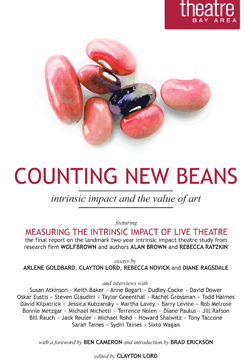Philanthropic practice
Jerry Yoshitomi, Meaning Matters LLC
Read More...Since the Ford Foundation’s institutional stabilization programs of the 1960s, arts funders have explored and implemented initiatives intended to promote the sustainability of arts organizations. Funding approaches, programs, and special terminology have been developed in support of the arts’ economic and social contributions to society. Artists and arts organizations are evaluated on the basis of their fiscal prudence and community contributions as well as artistic merit.
Read More...New research is exciting. It offers us a sense of discovery and possibility for change. Sometimes research findings become integrated into discourse and influence practice in the field. All too often, however, once the thrill of the discovery is over, many valuable research reports become “old news” and get filed on a shelf or in a deeply buried folder and are rarely looked at again. A great deal of useful information is therefore lost to practitioners, particularly to incoming generations of philanthropic leaders who may not even know that this research exists.
Read More...This original work of theater, commissioned by Grantmakers in the Arts for the 58th Council on Foundations Conference, was presented at conference plenary sessions, Monday, April 30 and Tuesday, May 1, 2007. Directed by KJ Sanchez and written by KJ Sanchez, Emily Ackerman, Aysan Çelik, Darrick Clayton, Michael Place, and Amy Kim Waschke.
Read More...Spurred on by technological advances, the number of aspiring professional artists in the United States has reached unprecedented levels. The arts’ current system of philanthropic support is woefully underequipped to evaluate this explosion of content — but we believe that the solution to the crisis is sitting right in front of us. Philanthropic institutions, in their efforts to provide stewardship to a thriving arts community, have largely overlooked perhaps the single most valuable resource at their disposal: audience members.
Read More...Recently I served as a panelist for the National Science Foundation’s Antarctic Artists and Writers Program. Forty-nine applicants wanted to be embedded in scientific research teams. They sought to explore the ethos, mythologies, and realities of this extraordinary continent.
Composers wanted to listen to the wind, water, animals, and shifting ice. Visual artists hoped to delve into infinite striations of whiteness: the effects of transparency on ice, the glitter of ice crystals, and light and shadow patterns on the surface and internal features of the frozen landscape.
Read More...He sat less than two feet away, with just the bare table between us. Everything seemed to be going well. We were talking about the value of creativity and innovation in education, commerce, and culture, and how incorporating creativity principles into curriculum development would improve school culture across his district. There were fervent nods of agreement, as we seemed unified in our conviction of the importance of creativity in developing twenty-first-century learning skills.
Read More...— Simon Dove, Utrecht Festival, Dance/USA Forum, January 2011
Why will some people engage with art in one setting, but not another? For example, why will someone watch great drama on television at home, but never darken the door of a theater? Why will someone listen to classical music in a place of worship, but not a concert hall?
Read More...Enriching our culture and engaging diverse and underserved communities, small arts organizations pop up, flourish, and sometimes flounder, mostly under the philanthropic radar. They often foster artistic expressions not adequately served by larger organizations.
Read More...
